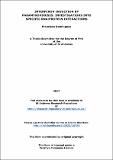Files in this item
Interferon induction by paramyxoviruses : investigations into specific RNA:protein interactions
Item metadata
| dc.contributor.advisor | Randall, R. E. | |
| dc.contributor.author | Dominguez Palao, Francisco | |
| dc.coverage.spatial | xxiii, 216 p. | en_US |
| dc.date.accessioned | 2017-05-11T14:53:43Z | |
| dc.date.available | 2017-05-11T14:53:43Z | |
| dc.date.issued | 2017-06-21 | |
| dc.identifier.uri | https://hdl.handle.net/10023/10750 | |
| dc.description.abstract | RNA:protein interactions are central in many cellular processes, including activation of innate immune responses against microbial infection. Their study is essential to better understand the diverse biological events that occur within cells. However, isolation of RNA:protein complexes is often laborious and requires specialized techniques. This thesis is concerned with attempts to develop an improved purification protocol to isolate specific RNA:protein complexes. Taking advantage of the specific interaction of the Pseudomonas aeruginosa PP7 protein with its cognate RNA binding site, termed the PP7 recognition sequence (PRS), the aim was to identify cellular proteins involved in activating cell-signalling pathways, including the interferon-induction cascade, following viral infection with stocks of parainfluenza virus 5 (PIV5) rich in copyback defective interfering (DI) particles. Copyback DI genomes are powerful inducers of IFN and, here, I show they also activate the induction of IL-6, IL-8 and TNFα; cytokines that also have antiviral properties. Following the successful cloning of the PRS into a copyback DI genome, we investigated conditions for optimal in vitro capture of DI-PRS:protein complexes by PP7 on Dynabeads. When tested, the protocol led to the successful capture of ILF3 and PKR, two dsRNA binding proteins induced by IFN. We further developed a tap-tagging system to minimize the presence of non-specifically bound proteins to Dynabeads that may interfere with future mass spectrometry analysis. To isolate DI-PRS RNA:protein complexes from infected cells, attempts were made to rescue replicating DI-PRS genomes in the context of wild type PIV5. Similarly, efforts were made to isolate influenza A virus RNPs that contained the PRS in the neuraminidase (NA) gene from infected cells using the PP7-based protocol developed. However, for reasons discussed, unfortunately RNA:proteins complexes were not successfully purified from infected cells in either case. | en_US |
| dc.language.iso | en | en_US |
| dc.publisher | University of St Andrews | |
| dc.rights | Attribution-ShareAlike 4.0 International | * |
| dc.rights.uri | http://creativecommons.org/licenses/by-sa/4.0/ | * |
| dc.subject | RIG-I | en_US |
| dc.subject | Paramyxovirus | en_US |
| dc.subject | Defective interfering | en_US |
| dc.subject | Interferon | en_US |
| dc.subject | PP7 | en_US |
| dc.subject.lcc | QP623.8P75D7 | |
| dc.subject.lcsh | RNA-protein interactions | en |
| dc.subject.lcsh | Paramyxoviruses | en |
| dc.subject.lcsh | Interferon | en |
| dc.subject.lcsh | Pseudomonas aeruginosa | en |
| dc.title | Interferon induction by paramyxoviruses : investigations into specific RNA:protein interactions | en_US |
| dc.type | Thesis | en_US |
| dc.type.qualificationlevel | Doctoral | en_US |
| dc.type.qualificationname | PhD Doctor of Philosophy | en_US |
| dc.publisher.institution | The University of St Andrews | en_US |
The following licence files are associated with this item:
This item appears in the following Collection(s)
Except where otherwise noted within the work, this item's licence for re-use is described as Attribution-ShareAlike 4.0 International
Items in the St Andrews Research Repository are protected by copyright, with all rights reserved, unless otherwise indicated.


